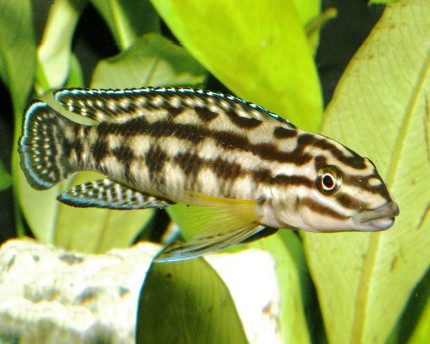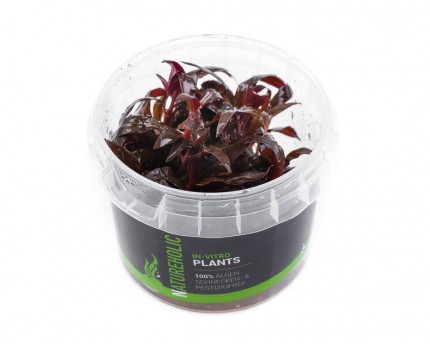incl. VAT plus shipping costs
Currently not available
Delivery only innh. Germany and Austria possible.
Switch to the German store
- Item no: 8144
Fast delivery times
All products are in stock with us!14 years of breeding experience
Let our team of experts advise you!High customer satisfaction
from over 3,000 reviews "| Pelvic region: | Center |
| Aquarium size: | 100 l (approx. 80cm) |
| Temperature: | 25-30 °C |
| Feature: | form family groups |
| with snails/shells?: | No |
| Fish group: | Cichlids |
| Visual effect: | Forms territories (when spawning) |
| Planting possible?: | conditional* (see description) |
| Diet: | carnivore - meat eater |
| Water values: | Hard water |
| with shrimps?: | Socialization not possible |
| Breeding: | medium |
| Difficulty: | 2 - Normal |
| Final size: | 4-8 cm |
| Origin: | Africa |
| Behavior: | Normal |
| with large crabs?: | No |
| with fish?: | conditional* (see description) |
| with dwarf crabs?: | No |
| with crabs?: | No |
From the East African Lake Tanganyika come the pretty Dickfelds slender cichlids, also called Julidochromis dickfeldi , which belong to the cichlids. They inhabit the rocky littoral near the shore and are found at depths of up to 35 meters. Due to their elongated body they differ visually from the typical high-backed perch, which is why they are also called slender cichlids. In the aquarium they fascinate with their great appearance and their social behavior.
You get our slender cichlid Dickfeldi in a size of 5 cm.
On their elongated body Julidochromis dickfeldi have a rather beige Grudnfärbung with free brown side stripes, which can be interrupted. Occasionally they also iridesce blue, the belly is bright. Two stripes also run below the eye; one brown and one turquoise. Likewise, the fins are transparently bluish in color, and the speckled dorsal fin has a light blue fringe. Juveniles develop their vibrant color as they age. They also have thickened lip bulges on their underslung mouth. The animals grow to a maximum length of 11 centimeters. The sexes are distinguished mainly by their genital papilla; that of the males is not particularly pronounced, if at all. However, females usually grow larger than males and become much bulkier at spawning time.
Dickfeld's slender cichlids can also be bred in the aquarium, coming together in pairs and living in so-called parental families. At mating time, however, the slender cichlids become quite territorial and also somewhat more offensive in their behavior. They occupy and defend territories. In caves and hiding places offered to them, the animals spawn on the ceiling, with the female sticking her up to 40 eggs. She cares for the spawn, from which the young hatch after about 3 days. After another week they can be fed with small live food such as nauplii. After that, their care fades away. Since slender cichlids hybridize with each other, you should never keep this species with other species of slender cichlids.
Dickfeld's slender cichlids can be kept in pairs or in a harem in an aquarium of 200 liters or more and have both sufficient caves and hiding places, such as can be provided with roots and stone structures that are secured against falling over. These should offer space to retreat, but also to swim through. Since especially the males tend to assert territorial claims, these serve among other things to delimit the territory and as a visual screen. The swimming space should not come too short. A fine to medium gra ined gravel is suitable as substrate, in which the animals can easily "dig", an appropriately dimensioned filter should keep the water hygiene constant. At a total hardness of 9-20 °dGH and a pH-value between 7,5 and 9,0, as well as a temperature of 24-26 °C the pretty slender cichlids can be maintained well.
In nature the carnivorous Julidochromis dickfeldi feed on insects, but also on fish larvae and other invertebrates, as well as small crustaceans - therefore dwarf shrimps or even crayfish are not suitable for socialization. In a very large aquarium, however, they can easily be socialized with other inhabitants of Lake Tanganyika such as Neolamprologus which we also offer in our store.
They can be fed without problems with commercial dry food in the form of flake food or granulated food, but also food tablets for carnivorous ornamental fish can provide these omnivores optimally. About regularly given treats in the form of Live food or Frozen food such as daphnia or artemia, they are very happy.
Our food recommendation: The NatureHolic Cichfeed has a grain size of 1.5 mm and is therefore also suitable for larger fish. The NH Cichfeed is a soft granulate for mainly carnivorous fish. It has the same consistency as small crustaceans and insect larvae that fish naturally eat, and the soft granules protect the fish's mouth from micro-injuries that can result from hard feed granules.
Our plant recommendation: Use for planting NatureHolic InVitros. These are free of snails, planarians and other unwanted co-inhabitants. Also free of algae spores, bacteria and fungi.
Expert Tip: We recommend for fish keeping the NatureHolic 3 Phase Liquid. The care set offers the best all-round protection for your animals. It ensures optimal conditions for successful breeding and keeping.
| Scientific name: | Julidochromis dickfeldi |
| German Name: | Dickfeld's slender cichlid |
| Difficulty level: | for beginners |
| Origin/Distribution: | Tanganyika, Africa |
| Coloration: | light base color with three prominent brown broad stripes, bluish sheen, turquoise stripe on face, bluish and speckled fins |
| Age expectancy | approx. 6 years |
| Water parameters: | GH 9- 20 °dGH, pH 7.5-9.0, temperature 24-26 °C |
| Tank size: | from 100 cm |
| Food | Carnivorous; granulated food, food tablets, flake food, live and frozen food, such as Artemia and mosquito larvae |
| Breeding | medium |
| Behavior | territorial in places and aggressive towards conspecifics |
| Group size | 2 and up |
| Further information | Ten typical aquarium fish for beginners and alternatives to them, Tips for acclimating fish to the aquarium, Feeding aquarium fish properly - cheap food and what it can do |
- Item no: 8144
Entdecke die Garnelio Welt!
Garnelio gehört zu den größten Onlineshops für wirbellose Aquarientiere weltweit.
Viele Artikel gibt es exklusiv nur bei uns im Shop.

























